The glam tour

Mike Murray, senior managing engineer in utilities distribution, points out features of a steam tunnel during the Wednesday morning tour. Photos by Christopher Gannon.
Many faculty and staff are making time this week to participate in events for the university's Faculty and Staff Appreciation Week, organized just before spring break to show appreciation for employees' commitment to the university during a two-year pandemic. As of early Wednesday afternoon, about 930 employees had registered for at least one experience. All events are free to participants. The project and registration websites will remain open through Friday (April 1) to allow employees to participate as their schedules change.
Utility services' steam tunnel tour proved to be like the elusive Willy Wonka golden ticket. The four scheduled tours had limited capacities and filled quickly (so Inside begged a spot on one and university photographer Chris Gannon captured some images for those who missed out). Power plant, brewing lab and letterpress lab tours also reached capacity, and the two announced happy hours -- Tuesday afternoon at Johnny's in Hilton Coliseum and Thursday midday at the ISU Book Store -- also drew lots of participants. Bowling at CyBowl, a craft project at the Workspace and a scoop of ice cream at the ISU Creamery with the completion of a selfie assignment, none of which had daily limits, also were popular.
Thank you to the units, teams and individuals who are hosting appreciation week events.
Supervisors are asked to permit their employees reasonable participation in appreciation week while still meeting office needs. Nonexempt staff should remain on the clock if they participate in events during their normal work hours.

Kyle Martin, contract associate at the ISU Research Park, bowls under the black lights of CyBowl & Billiards in the Memorial Union Tuesday afternoon.
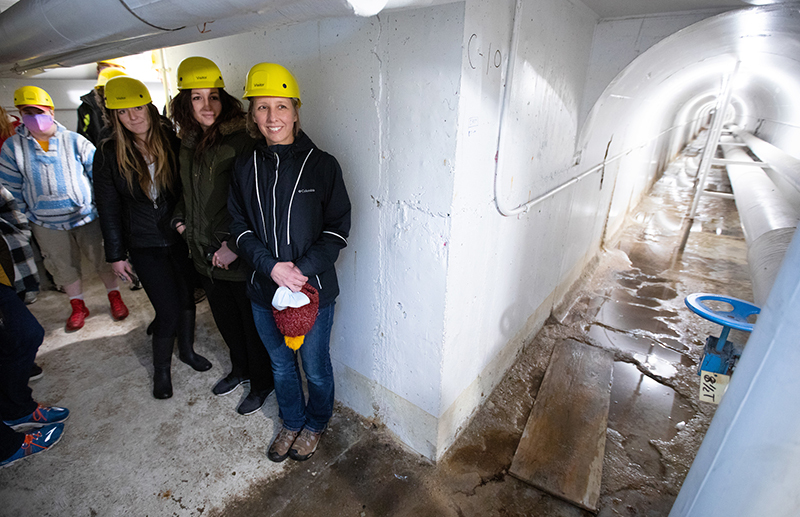
Participants in Wednesday's steam tunnel tour hug a dry stretch of floor while they listen to tour guide Mike Murray, utilities distribution.
WorkFlex requests due April 1, full-remote pilots move ahead
The employee application window closes Friday, April 1, for the next round of WorkFlex arrangements, which can begin May 16. Staff who already submitted a new request or have an approved request from the first application window that takes them through at least Aug. 21 don't need to take further action.
Under WorkFlex, staff can request flexibility in when, where and how they work if it fits with their job duties and their unit's mission, including a hybrid schedule with partial remote work, a compressed workweek of fewer but longer days, reduced hours or schedules that fall outside of normal office hours. About 600 staff have been using the WorkFlex program since it launched at the start of the spring semester, said university human resources benefits director Ed Holland.
A knowledge base article in the ISU service portal explains how to apply in Workday. See the WorkFlex webpage for more information about the program.
Holland said a change in how WorkFlex requests are made since the first round of applications may help in considering future program adjustments. WorkFlex requests are now incorporated in Workday as a business process, making WorkFlex data easier to access and analyze.
Remote pilots move forward
Since July 1, admissions and information technology services (ITS) have been among the units allowing eligible staff to work 100% remote on a trial basis. Admissions and ITS staff performed well during the pilot, convincing university senior leaders to approve both units making full-time remote work a part of their normal operations. They can begin designating positions as remote beginning May 1, Dwaine Heppler, associate vice president for human resources delivery and strategy, announced in memos sent to the unit leaders March 25.
The decision potentially affects about 130 admissions and ITS staff and allows the units, effective April 1, to begin recruiting and posting for positions that are fully remote. Remote employees are required to live in Iowa.
Approving remote work in certain units is an incremental step toward consideration of additional flexibility under WorkFlex, which currently caps remote work at 60% of the week as part of a hybrid schedule, Heppler and Holland said.
"These pilot programs have demonstrated that, for these two units, fully remote work has worked really well," Heppler said.
The pilots in admissions and ITS were assessed in part on customer response and employee survey data, Heppler said. Both units also saw an uptick in employee engagement and retention.
Other remote work pilots are continuing, including in finance service delivery, procurement and payroll, Heppler said. Though they've been successful, they are waiting for additional data before making any changes or decisions.
Retirement incentive proposal goes to regents
Iowa State will present a proposal for a specialized retirement incentive program (SRIP) to the State Board of Regents when it meets next week in Ames. If approved, the SRIP would be limited to tenured faculty in the College of Liberal Arts and Sciences (LAS) or in one of the six departments LAS jointly administers with the College of Agriculture and Life Sciences.
The retirement option is one of the first components announced in LAS' multiyear plan to resize its budget to reflect changes in student enrollment and demand for academic programs. The intent is to meet its budget goal by June 2026.
The board will meet in the Reiman Ballroom at the ISU Alumni Center Wednesday afternoon, April 6, and Thursday morning, April 7. The agenda is online, and open portions of the meeting will be livestreamed on the board's website.
As proposed, the application window for the retirement incentive program would be Oct. 3-Dec. 2 this fall, with retirement required by June 30, 2023. Besides tenure, other proposed eligibility requirements are:
- Age plus continuous service (on retirement date) total at least 70 years
- Minimum age (on retirement date): 60 years
- Eligible for Iowa State benefits
- Employee isn't already participating in a retirement plan and didn't previously receive permission to retire or resign
Participants would select from two incentive options:
- Two years of health and dental coverage (employer and employee costs) up to the self and spouse/partner level; and two years of monthly employer's retirement contributions. IPERS plan participants would receive all contributions in one up-front payment.
- Three years of employer's retirement contributions (again in one payment for IPERS plan participants).
These mirror two of the three options in Iowa State's 2021 retirement incentive option program, which 318 faculty and staff participated in as part of a broader university plan to trim operating budgets in the face of reduced state appropriations and tuition revenue.
An estimated 127 tenured faculty would be eligible for the focused program. Actual savings would depend on how many faculty participate and which incentive option they select. The university would report participation and savings data to the board at its September 2023 meeting.
Promotion and tenure requests
Iowa State leaders also will seek final approval for promotions for 76 faculty for the 2022-23 academic year. That compares to 69 requests (33 female, 36 male) a year ago and 98 (49 each) in spring 2020. Once the board approves the promotions, the full list will be posted on the provost's website. The recommended promotions are:
ISU faculty promotions: 2022-23
|
Action |
Female |
Male |
Total |
|
Promotion with tenure |
15 |
32 |
47 |
|
Promotion (already tenured) |
3 |
25 |
28 |
|
Tenure only |
0 |
1 |
1 |
|
Total |
18 |
58 |
76 |
In anticipation of board discussion about fiscal year 2023 salary increase parameters at the June meeting, representatives of the three universities for employees not covered by a union contract will share comments with the board. At Iowa State, those include supervisory and confidential staff, professional and scientific staff, and faculty.
Iowa State requests
In other business, Iowa State will seek board permission:
- To add two graduate degree programs: a master of entrepreneurship in the department of management and entrepreneurship, and a master of community development in the College of Design.
- To close the Center for Catalysis in the College of Liberal Arts and Sciences on June 30.
- To add a new major, professional studies, to the Bachelor of Liberal Studies program at all three regent universities. Each school would be able to have select areas of emphasis, minors or certificates available to its professional studies students.
- For parking permit rates for the year that begins July 1.
- For student housing and dining rates for the year that begins July 1.
- For a $3 million project to replace the 24-year-old roof and heating, ventilation and air conditioning (HVAC) rooftop system at the Administrative Services Building, and tie in the new HVAC system to the campus chilled water system. If approved, the project could begin this summer and conclude in fall 2023.
Presentations
These ISU faculty and staff will participate in presentations to board members:
- Dean of library services Hilary Seo, update on library collaborations, to the academic affairs committee (Wednesday afternoon)
- Vice president for diversity, equity and inclusion Sharon Perry Fantini, annual update from university diversity officers, to the campus and student affairs committee (Wednesday afternoon)
- Director of student wellness Brian Vanderheyden, presentation on campus substance abuse support, to the campus and student affairs committee (Wednesday afternoon)
- Professor of electrical and computer engineering Hongwei Zhang and professor of mechanical engineering Baskar Ganapathysubramanian; joint presentation on two new ISU research centers that support Iowa families and industries, to the full board (Thursday morning)
Process streamlined to simplify hiring temporary workers
Several changes effective April 1 will streamline hiring temporary workers, including a smoother process for retaining graduating hourly student employees.
The changes only apply to temporary employees hired on a short-term basis, up to 780 hours per fiscal year, often to cover for an employee on leave or to take on a special project. Amy Mann, university human resources (UHR) associate director for talent acquisition, announced the updates in a March 21 memo to hiring managers. Here's a look at what's changing:
Hourly student workers
In a typical year, UHR processes about 200 temporary hires, and student hourly workers make up more than 25% of the transactions. Student workers who aren't registered for classes -- after graduation, for instance -- have been required to complete an application to be hired as a temporary employee.
Now, students who are registered for classes in the fall can remain a student worker in the summer, and HR delivery can transition graduating or unenrolled students to be temporary employees without a new application. HR delivery will prepare an offer letter for the shift to a temporary employee, which the employee and hiring manager must sign.
Some processes stay the same, such as graduating international students not being able to work in an hourly position beyond the last day of the semester they graduate. Additionally, graduate assistants transitioning to be a temporary employee also must still apply for the new temporary position, as in the past.
The student employment guidance will be updated April 1 to reflect the updates.
Supervisor approval
Another change gives direct supervisors final approval for hiring temporary workers, instead of the appointment authority -- often a department head or a higher-level leader. Department heads and other unit leaders should provide hiring managers clear expectations for hiring temporary employees. ​​The policy will be updated April 1 to reflect the supervisor’s authority for hiring.
Merit classifications
In the past, temporary merit employees have been hired into specific job profiles that align with their duties. Due to changes in state Board of Regents system rules and in collaboration with other state agencies, most temporary merit employees now will be hired into one of two temporary profiles: clerical helper or helper. That will make job duties and compensation for temporary employees more flexible while performing in temporary roles.
This change will not affect temporary hires in some positions where the duties are an exact match for an existing job profile -- veterinary technicians, for example.
Policy clarified
As part of the streamlining effort, the appointment duration policy for professional and scientific employees will be updated to clarify that temporary P&S staff are limited to 780 hours per fiscal year and ineligible for benefits. Individuals can work in more than one temporary position, but all hours worked count toward the 780-hour cap, which is a little less than 20 weeks of 40-hours-per-week work.
The 780-hour limit was temporarily lifted by the state Board of Regents during the pandemic, but the waiver is set to expire June 30. As is customary, the hours calculation for hitting the annual limit will restart July 1.
Questions?
Supervisors can contact HR delivery if they have questions about these changes.
Senior persists for newest flavor at campus creamery
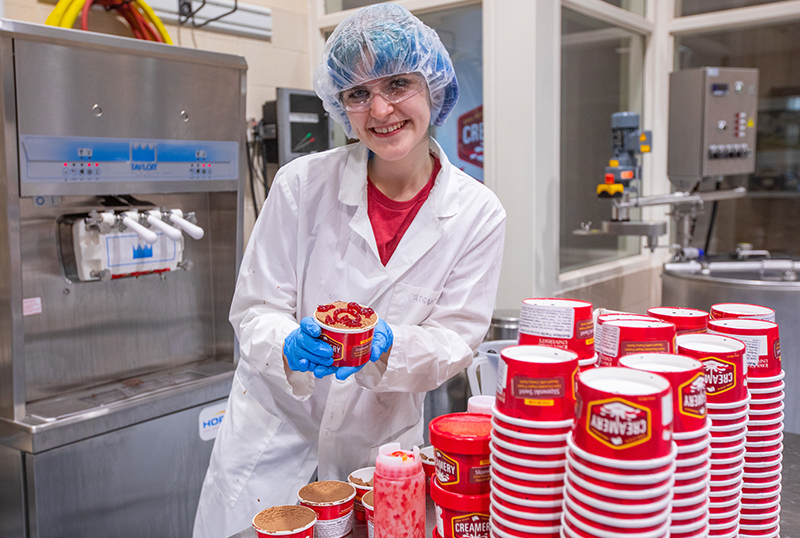
Senior Lucy Slizewski hand packs 8-ounce cartons of Slizewski Swirl, which she developed, March 11 in the Food Sciences Building. Photo by Christopher Gannon.
The newest product at the ISU Creamery doesn't contain cow's milk, part of why it gave a determined culinary food science major the biggest challenge of her undergraduate years. It also helps the creamery offer a treat to nearly every customer who comes in.
Try it
Slizewski Swirl is available by the quart or 8-ounce cup at the ISU Creamery, 2953 Food Sciences Building, and Sparks, 4220 Student Innovation Center.
"Slizewski Swirl" -- cherry swirls in dark chocolate -- is a non-dairy frozen dessert that avoids six allergens associated with many sweet treats: milk, egg, soy, wheat, peanut and tree nuts. ISU Creamery intern and May graduate Lucy Slizewski developed it over 18 months of trial and error, aided by feedback from director Stephanie Clark, business administrator Sarah Canova and other faculty members in food science and human nutrition.
"We are a research institution. Research and education opportunities for our students come first at the ISU Creamery," said Clark, acknowledging it's a bit unusual for a dairy facility to pursue a non-dairy product.
Pursuing inclusivity is not.
"If an entire family walks in, we want to have a product that works for each of them," she said. "We don't want anyone to walk away disappointed."
Since the creamery opened in August 2020 on the second floor of the Food Sciences Building, Canova said student employees have fielded inquiries from customers allergic to dairy or eggs. The creamery's 19 ice cream flavors start from one of five bases Clark developed, all of which contain both.
Slizewski, who has to limit her dairy consumption, started her internship that fall and offered to research a vegan option.
"She's self-motivated, and we could see she had the tenacity to work through failures," Clark said. "We encourage student innovation, and that's what this is all about."
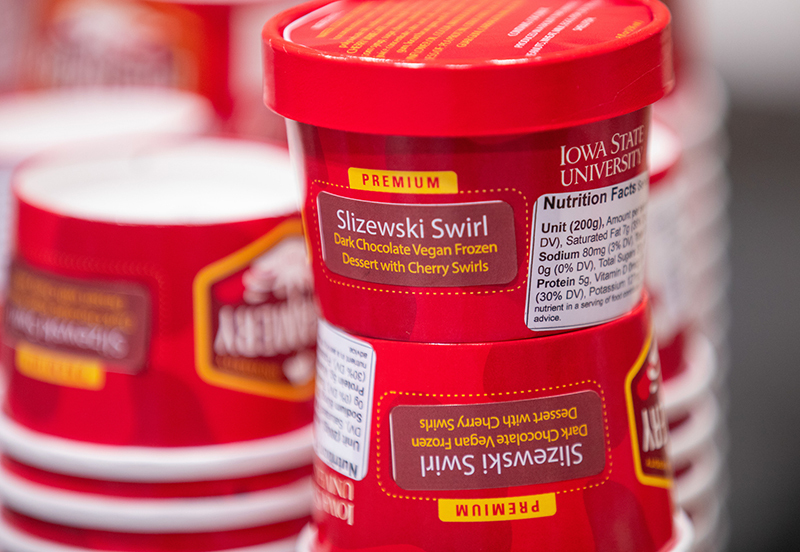
Slizewski estimates she produced about 15 trials in eight-cup batches, the first few of which were "really discouraging" in their flavor and texture. She started with almond milk but eventually landed on coconut milk for its fat content and ability to mimic some properties of cream. Along the way, she also tried and rejected ingredients such as pumpkin protein, chickpea flour and vegan marshmallows.
The turning point came, she said, "when I stopped treating this as ice cream. Once I took that into consideration, I made better progress."
In the end, she honed in on coconut milk, sunflower oil and pea protein as her primary ingredients, with maltodextrin as the binding agent of choice. Then, it was a matter of fine-tuning the ratios.
The first scaled-up batch rolled out of the ISU Creamery's production facility March 11, with Slizewski hand-packing it herself. ISU Creamery customers have been able to buy it since the end of spring break.
After enduring some product experiments that "resembled hummus more than ice cream," she said she's especially proud of Slizewski Swirl's creamy texture.
And the name? Clark proposed it, though she and Canova both expected the humble Slizewski to pass. But Slizewski acquiesced, in part she said for her dad in Slinger, Wisconsin, who would enjoy seeing their not-so-common family name on a food package his daughter helped create.
Systematic approach will detail impacts of WorkCyte Phase II
Faculty, staff and students will be hearing a lot about "change impacts" during WorkCyte Phase II, the multiyear project to implement Workday Student and Receivables software.
The WorkCyte Phase II project will replace systems such as ADIN and AccessPlus with more modern software products in a series of deployments from summer 2023 to late 2024, a transition that also involves reviewing and improving business processes. Significant adjustments to procedures and processes will be highlighted as a change impact.
Change impacts are being identified and catalogued on the WorkCyte website, each including an analysis of the difference between current and future operations, timing, who will be affected and potential implications. The collection can be filtered by impacted audience. Other methods of filtering may be added as the number of change impacts grows, said Shannon Grundmeier, a change specialist for information technology services.
Change impact analysis focuses on identifying how unique audiences will be affected by changes in functionality and workflow with the new software. Understanding the scope of change impacts informs what communication and training may be needed on campus, helping to ensure a successful adoption of Workday Student and Receivables, she said.
"In response to feedback received after the deployment of Workday Human Capital Management and Finance, our team hopes to provide increased awareness and knowledge of anticipated changes and impacts associated with the WorkCyte Phase II project. By utilizing a structured change management approach, which includes proactive communication and campus engagement strategies, we hope to support a smooth transition for members of the ISU community," she said.
Grundmeier said that begins by increasing awareness and transparency about what is changing and why, describing how these changes will impact employees and students in work and education settings, and delivering training opportunities.
"The goal is to provide the necessary information, knowledge and skills to effectively use our new tools and processes in Workday and ease the psychological burden that often accompanies change," she said.
Three change impacts are already identified: automated prerequisite checking, controlled enrollment and reserved seating, and expanding course numbers to four digits. Each of the impacts -- all go into effect in March 2024, for fall registration -- includes a description of what's changing and a breakdown of benefits and challenges. See the change impacts webpage for more details.
Faculty and staff with questions or feedback about change impacts can contact their change liaison or email comments to the project team.
Central campus plaza opens this weekend
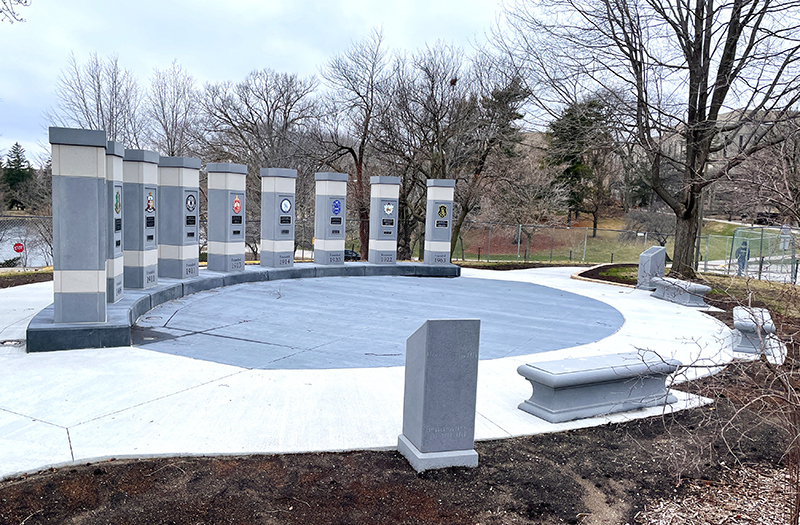
Construction is complete (landscaping to come this spring) on the National Pan-Hellenic Council Plaza on the northwest lawn of the Memorial Union. A ribbon-cutting event Sunday, April 3, will officially open it as an event space for student organizations. Photo by Christopher Gannon.
By this weekend, the construction fence will come down around the National Pan-Hellenic Council plaza on the Memorial Union (MU) north lawn and the site can be used as intended -- a gathering place and event space for students.
The campus community is invited to a public ceremony, ribbon cutting and reception Sunday, April 3, celebrating the plaza's completion. It begins at 1 p.m. in the MU Great Hall.
The plaza's nine columns honor the nine historically Black fraternities and sororities of the National Pan-Hellenic Council (NPHC), eight of which have chapters at Iowa State. It includes seating and historic information about the NPHC, but a key feature is open space. Associate vice president and dean of students Sharron Evans, a Delta Sigma Theta sorority member, said that's the point.
"That was very intentional so there can be activity on the plaza, an active space where students can engage," she said. "And it's not just for those who belong to Black Greek letter organizations. It's for everyone to enjoy, because the plaza also is an educational tool."
Evans said Black sororities and fraternities typically don't own houses near a university campus, and where they do, they're often not part of a "Greek Row." The plaza represents the Iowa State home of the Black Greek organizations and "says they're a part of this university community," she said.
The decision to locate the plaza on a prominent, central campus corner reinforces that statement, she added.
"We want all students, faculty, staff and campus visitors to enjoy that space, and at the same time honor the history that goes with those organizations and the need for that space on our campus," Evans said.
The plaza dedication is part of a reunion weekend for members and alumni of the NPHC that includes campus tours, Saturday breakfast hosted by students and a Saturday evening gala.
The National Pan-Hellenic Council at Iowa State
The NPHC was founded in 1930 at Howard University, Washington, D.C., with five charter organizations:
- Alpha Kappa Alpha sorority
- Delta Sigma Theta sorority
- Zeta Phi Beta sorority
- Kappa Alpha Psi fraternity
- Omega Psi Phi fraternity
Since then, the council added four organizations:
- Alpha Phi Alpha fraternity (1931)
- Phi Beta Sigma fraternity (1931)
- Sigma Gamma Rho sorority (1937)
- Iota Phi Theta fraternity (1997)
All but Iota Phi Theta have a chapter at Iowa State. The NPHC and Iowa State have a long history. For example, two of the university's most famous Black students, George Washington Carver and Jack Trice, were members of NPHC fraternities Phi Beta Sigma and Alpha Phi Alpha, respectively. Iowa State chapters for two others, Delta Sigma Theta sorority and Kappa Alpha Psi fraternity, are single letter chapters -- among each group's earliest.
Evans said she anticipates completion of the plaza in a prominent location will help renew interest and recruitment in the eight organizations.
Fundraising continues
The student affairs division provided seed money to construct the plaza, with the goal of covering most of the estimated $400,000 cost with private gifts. University alumni, friends, employees and current students already have supported the project, and fundraising efforts are ongoing, including a FundISU site, which will remain live for several weeks this spring.
Dana Savagian, associate director for annual and special gifts at the ISU Foundation, said it's likely the account supporting the plaza will remain open for years to come, since upkeep is critical to maintaining the plaza. The foundation also has a printable form for pledges, including a payroll deduct option. The form, or gifts by check, can be mailed to: ISU Foundation, PO Box 2230, Ames 50010.
Despite lack of moisture, campus expected to pop this spring
Much of the state has drought concerns following a fall and winter that saw moderate precipitation, but the Iowa State campus figures to be in its postcard-perfect form when spring fully blooms.
"It is dry, but I would say that we are not even in a moderate drought right now," campus services senior manager Barb Steiner said. "We are at that point where any rain helps."
Steiner said February helped ease dry conditions, with about 2.5 inches of moisture falling on campus. The past couple of weeks added rain on numerous days, providing signs of a vibrant campus.
The lack of snow -- just one major storm hit campus, dropping nearly 13 inches -- led to facilities planning and management (FPM) crews spending less time on snow removal than in recent years. Extreme cold without snow cover can cause issues for perennials and other flowers, but Steiner said she is already seeing some bulbs popping.
"I don't think it will be an issue this year because it wasn't cold enough long enough," she said.
Less snow meant more time to get other projects completed, including the removal of dead ash trees and other pruning across campus. Employees also got a head start on equipment maintenance, meaning the lawn mowers will be ready to roll in April.
FPM's 51 campus services employees conduct a spring cleaning that includes leaf and stick removal, cleaning of flower beds and sweeping of sidewalks.
"We want to get the sand we put down in the street picked up by the street sweeper to keep it out of the streams," Steiner said.
Upcoming projects
With the expansion of parking lots B1 and F at the Iowa State Center, FPM will transplant trees from the area this week. They are being moved north and west of the current location, just outside the work zone. The lots north of Scheman Building and west of Fisher Theater are being expanded into an L-shaped lot that adds 380 parking stalls to the corner.
The biggest landscaping project over the summer will surround the pedestrian bridge over University Boulevard east of Jack Trice Stadium. The gateway project features an elevated walkway to the stadium's east concourse to create a safe pedestrian route between the stadium and parking.
"It is a significant planting project that has over 250 trees going in at that site," Steiner said. "There also are plans to put perennial shrub beds and flowering trees underneath the bridge on both sides."
The project is scheduled to be completed in time for the season-opening football game against Southeast Missouri on Sept. 3.
ISU Theatre breaks new ground with latest musical
How will ISU Theatre's spring musical, "BABA," look and sound when it opens April 7 in Fisher Theater? Even the cast and creative team aren't 100% sure. ISU Theatre is workshopping a musical for the first time, collaborating with New York-based composer Elliah Heifetz and librettist Jessica Kahkoska.
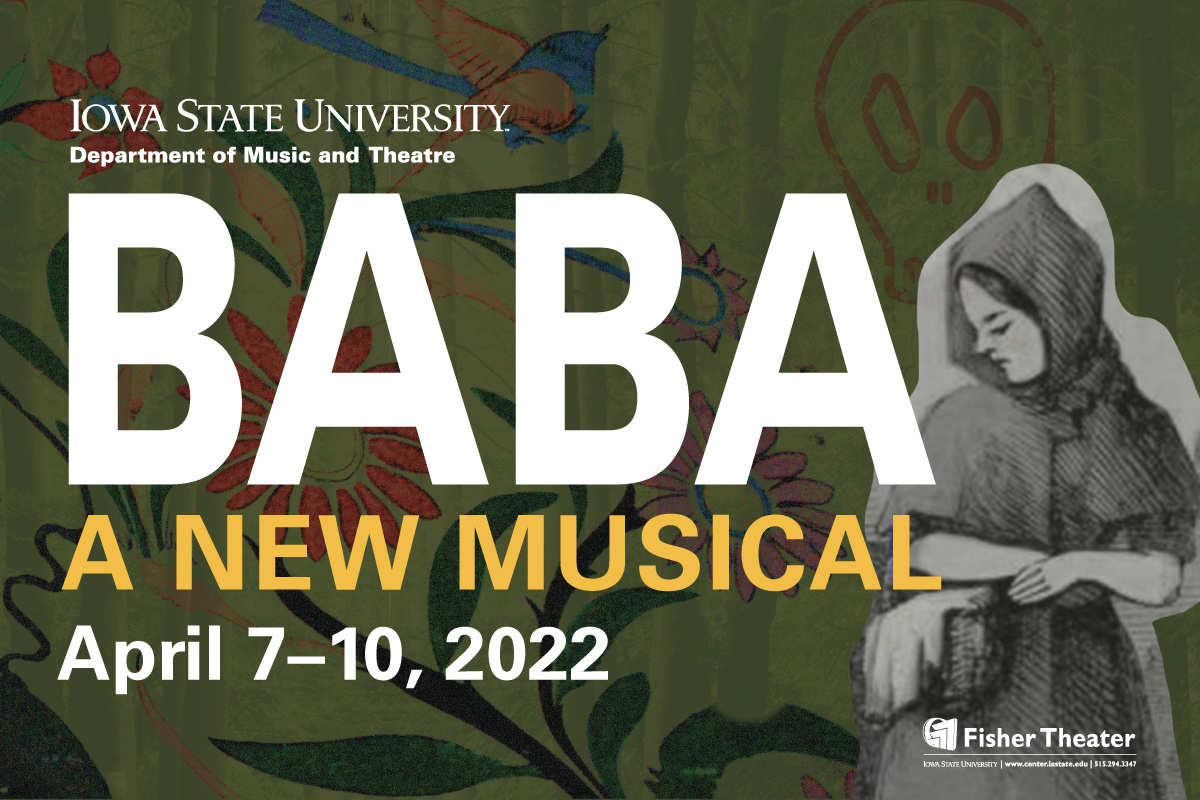
Workshopping, in theater terms, gives playwrights, producers and composers a chance to develop and improve their material before scaling a full production. They can see how audiences react to a story, learn if the material is ready for actors and singers, and even write new pages or songs up to the last minute.
The workshop process is an innovative hands-on learning opportunity for Iowa State students.
"Out in the real world, if you're lucky enough to be working on a new production, you will have people responding in real-time," said Cason Murphy, assistant professor of theatre and the show’s faculty director. "It's less theoretical than what we talk about in our classes. We're bringing the playwright and the composer right to them. This is thrilling and exciting because it gives students some say over the final product in a way that usually doesn't happen."
Performances for "BABA" are at 7:30 p.m. April 7-9 and at 2 p.m. April 10. All seating is general admission. Tickets ($25 for adults, free for Iowa State students and youth) can be purchased at the door, the Stephens Auditorium ticket office or through Ticketmaster.
The right project for ISU Theatre
Last summer, ISU Theatre issued a call for musicals to workshop on the New Play Exchange, a digital script library. Murphy received more than 100 submissions. During a conversation with Heifetz and Kahkoska about their pitch, he learned they had another story on the back burner that seemed to check all the right boxes for ISU Theatre -- a contemporary musical with an ensemble cast and a story focused on relevant, timely issues.
"BABA" is the tale of teenage climate activist Sylvie who lives at the edge of a forest in Appalachia. When Sylvie ventures into the forest on a mission to save it, she meets an old woman who turns out to be Baba Yaga, the mythical witch of Russian folklore. Sylvie and Baba Yaga realize they are entangled in the strands of a bigger, darker story, and the pair must learn to trust one another. The contemporary musical score interweaves the enchanting sounds of Americana, Russian folk and pop.
'Pieces of gold'
Workshopping a production gives students better insight into industry practice, where a show is created over months, or years, with many revisions. "BABA" also is the focus of a new Iowa State seminar class this spring, Advanced Musical Theatre, so students can learn inside and outside the classroom.
"Every time I come into rehearsal, I'm most excited to learn from everyone else," said Breanna Penenger, senior music major and cast member. "The cast and team bring in these little pieces of gold to every rehearsal, which inspires me to dig deeper as an artist and contribute as well."
Murphy said workshopping "BABA" has uniquely engaged students’ imaginations and challenged their problem-solving skills.
"It makes them more dynamic as theater-makers," he said. "That's what we're after in this department. It's not a conservatory approach. It's a liberal arts view of creative people who are engaged with all aspects of this art."
